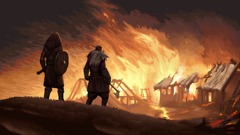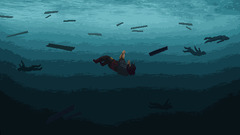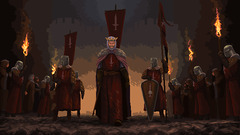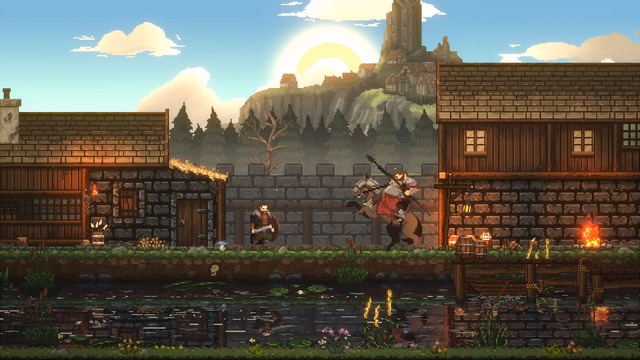Ah, the age of the Vikings (or Northmen, to be exact). A time of adventure, blood and pillage, but also of trade and unsuspected cultural exchanges. I have always been fascinated by this age, it is normal that Sons of Valhalla intrigues me with its subject.
It also interests me because the game strongly resembles the games in the “Kingdom” series that I have already mentioned several times in the past on JeuxOnline. Sons of Valhalla delves deep into the world of violence, pillage, and war that I mentioned earlier. From the start, the introduction immerses us in the action, showing our hero in front of his burning village, his murdered family, his kidnapped wife, all in a remarkable pixel art style.
Advertisement
In his quest for revenge, our hero sets out in pursuit of the warrior responsible for the massacre. However, the seas prove cruel and his ship sinks, leading to his death… well, almost. Fortunately, Odin intervenes. Our hero then finds himself in Valhalla, where the father of all explains that his time has not yet come. He sends him back to the world of the living to fulfill his destiny. Odin, intrigued by the potential of humans, counts on their help during Ragnarok. He also warns that our hero will likely die again in his quest for revenge and that each death will be compensated by a “rune” to sacrifice to return to Midgard via Heimdall's Bifrost, the Rainbow Bridge. We will return to this point later.
Back on Midgard, precisely on the English coast, our hero is one of the rare “survivors” of the sinking of his ships. However, others are soon arriving to form the core of our army. Indeed, Sons of Valhalla focuses more on combat than the Kingdoms from which it is inspired. All the gameplay takes place on a plan 2D horizontal. Your progress confronts you with different obstacles, often of increasing difficulty. Eliminating enemies gives you resources, while capturing areas gives you some logistics to improve your army, whether by equipping your men or introducing new unit types (archers, rams, etc.). And of course, what made the Vikings famous: the shield wall. The latter is of paramount importance for your progress, because you will often find yourself confronted with fortifications which will put your army to the test. Without a wall, you risk suffering heavy losses when trying to bring down the fences blocking your path.
So the entire gameplay boils down to a constant back and forth movement, from left to right, to conquer enemy strongholds while protecting your own. It's essential to prepare thoroughly in advance, because without the right upgrades and equipment, you risk hitting a wall at the first real fortress you encounter. Your character issues orders, easily executed via a toothed wheel (like in controller gameplay), but also participates in combat. As you progress, you discover runes, sometimes in altars, chests, or even by recovering them from defeated enemies, which you can equip. These runes provide various bonuses in different categories: personal, for your troops, for logistics, etc. However, fighting alongside your men inevitably puts you at risk of death, and in this case one of these runes must be sacrificed to continue your adventure, giving the game a roguelike feel.
Don't forget to take your own evolution into account either, because at the end of each levelyou must face the boss in solo. Each one has specific gameplay, which reminded me of the good old bosses of old platform games. This is actually a positive point, especially since they are very well designed in terms of character design.
Advertisement
The first level offers a perfect introduction to the game, but from the second level, the challenges become considerably tougher. This is why I emphasize the importance of preparing carefully and progressing without rushing. In mass combat, while your hero is obviously crucial, he is only one link in the chain that can tip the balance of battle one way or the other. Often, he must retreat to heal, re-equip, or seek new soldiers to maintain the front line. During its withdrawal, your men continue to fight to advance. Not strengthening them sufficiently would mean sacrificing them unnecessarily.
There are five levels in the game, all starting the same way: you build your base which you develop (with a maximum of 6 constructions), take outposts which provide you with special “heroes” (special mention to the healer , very useful) which, of course, cost you more, given that you are limited in the number of troops you can command simultaneously. You train your army, adapt it according to your needs and so on.
In summary, it is a very pleasant game which will satisfy fans of war strategy. The gameplay that made Kingdoms so successful has been intelligently adapted here to place more emphasis on combat. If you enjoyed the games that inspired this one and if you're interested in the theme, don't hesitate to play it, it's worth it.
Game tested on PC by Seiei with a version provided by the publisher.




